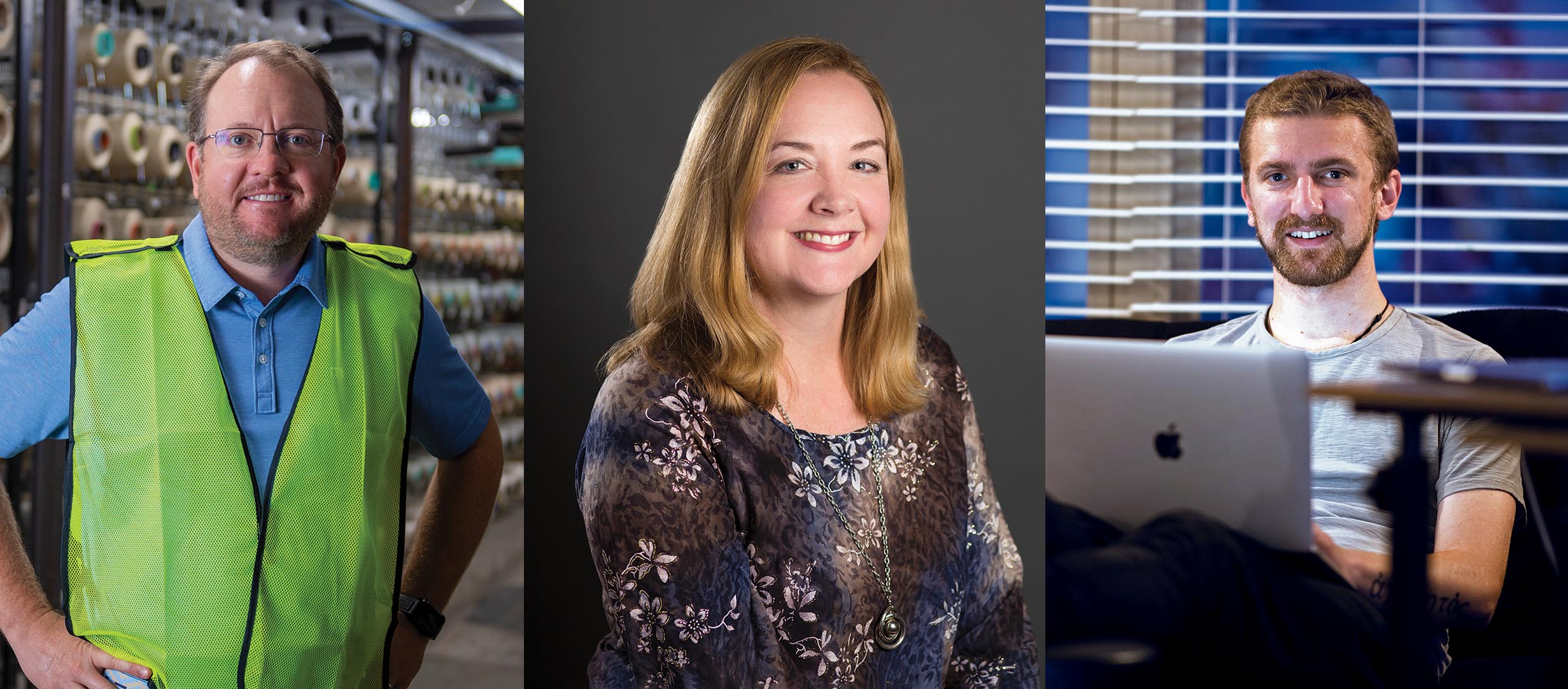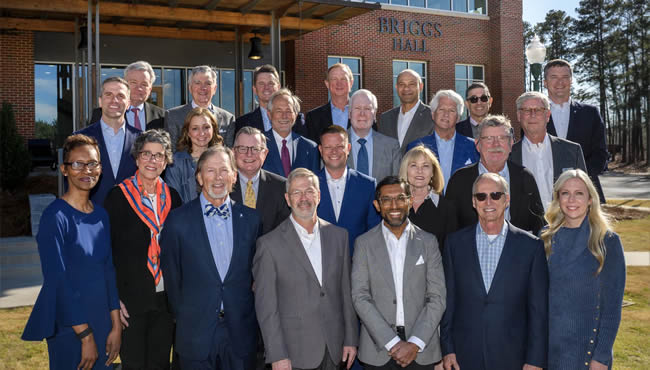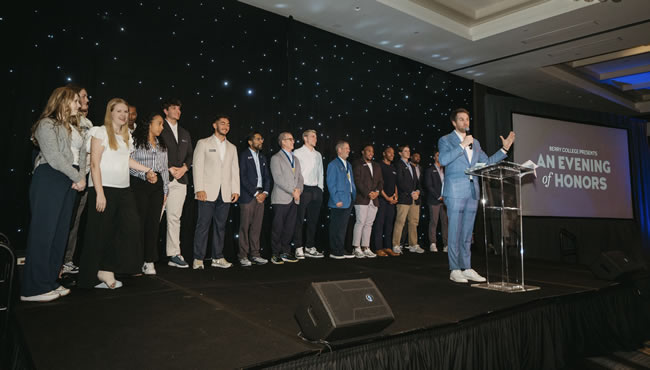By Karilon L. Rogers
In the earliest days of the COVID-19 pandemic, help was needed seemingly everywhere.
People sickened by the virus urgently needed medical attention, and their frontline caregivers just as critically looked for help acquiring the elusive personal protective equipment that might keep them from becoming patients themselves. “Essential workers” everywhere required support so that prescriptions and refrigerators could be filled and, inexplicably, precious toilet paper hoarded. And literally everyone awaited tests and treatments for this never-before-seen virus in hopes its trail of illness might be halted.
Many Berry alumni, students and friends answered the call to service in critical and creative ways in those terrifying early days, when so little was known about the invisible invader. We are proud to tell the story of three Berry graduates who stepped up with their heads, hearts and hands, each in his or her own unique way, to help their fellow Americans.
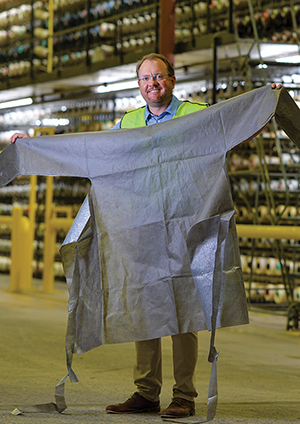
Bart Hill (97C)
Isolation gowns
by Mohawk Home
Bart Hill is a businessman who, just once, wanted to get put out of business. Fast.
In those frightening early days of the COVID-19 pandemic when hospitals and other first-responders were desperate for personal protective equipment, the senior vice president of Mohawk Home in Dalton, Ga., and his team used what they had in their bath- and area-rug operation to ultimately produce 155,000 isolation gowns and 235,000 plastic face shields. But these weren’t product lines they hoped to keep.
“This is the one business where I hope I get put OUT of business very quickly!” he said at the time. “The day I can shut this line down will be one of the happiest days of my life.”
The gowns went to more than 100 hospitals with focus on the local area – Dalton, Calhoun, Rome and Atlanta – as well as to AdventHealth, which has hospitals in nine states, including Georgia. Many were provided free of charge; some were offered at cost. The face shields, produced over a short six-week period, were shipped, again at no profit, throughout the Southeast.
“If I had had 10 million gowns, I could have shipped them,” Hill stated. “I figured at the time the shortage was probably 500 million gowns.”
Where There's a Will
“The first thing we did was try to figure out what we could make for our employees,” Hill explained. “We have expertise in sewing because of our bath rugs, so our idea was face masks. We made some, but our material wasn’t right to be next to your face, so that lasted for a week.”
In the meantime, he received call after call from local hospitals desperate for isolation gowns. His response was that he likely could make them but needed raw materials.
“I quickly learned that all the raw material comes from China,” he recalled. “I learned more about PPE in a week than you can imagine!”
Fate – and friendship – intervened. On March 23, he had just gotten off the phone with yet another hospital when lifelong friend Chris Simuro, owner and president of Fabric Sources International, called. Chris had rolls of fabric approved for use in isolation gowns but no way to make them.
“He had the fabric; I had the expertise,” Hill said. “I put a group of engineers on it, and on March 30, we had our first prototype – there were eventually 10 iterations. I put two people who sew on it, and we set a goal to make 10 a day. Then I got calls from Emory [HealthCare]. We added sewers and upped our goal to 100 a day. We made 500 the first week. That excited us, and we thought, ‘Let’s keep going!’ The Mohawk team stepped up. They wanted to help. I can’t say enough about them.”
When Hill’s team hit 1,000 gowns, the local news came. Every day they made more. By mid-April, they were making approximately 5,000 a day – a far cry from their original goal of 10.
“Emory loved the gowns,” Hill declared. “Our pattern worked better for them, and the FSI material was better.”
All in all, Hill and his team had a 12-week run before turning gown-making over to companies by then more capable of high-volume production. Still, the team continues to help the cause, having offered their gown template free-of-charge to any firms wanting to use it. Multiple companies have accepted their offer.
“I like to say, ‘If you can’t do what you do every day, do what you can,” Hill concluded about the experience. “Our people are all about helping. For a while, it was bad news after bad news. The ability to help out was a bright spot for our company and for me personally. I just directed traffic. It was the team that did the heavy lifting.”
Setting Course
In his early days, Hill never pictured himself as senior vice president of anything. His future was on the links, carefully avoiding disaster as he made his way around Amen Corner to win the Masters. Or at least putting his way to victory on some secondary professional tour.
It was an upper-level business management class with David C. Garrett Jr. Professor of Business Administration Dr. John Grout that awakened in Hill the excitement that can be found beyond the fairway.
“It was the best class I ever had and had a huge influence on me,” he said. “That was when I decided to go into business as a career instead of becoming another unemployed golf pro.”
Hill worked at Mohawk over the summer after graduation, planning to start a job he’d secured in Atlanta that fall. Mohawk held on to him, however, and 23 years later has never let go.
His Berry connections haven’t let go either. He still takes golf trips with his former teammates and now serves his alma mater as a member of the Campbell School of Business Executive Advisory Council. He also is a hearty supporter of the Save a Student Scholarship, which has been helping students severely impacted financially by the pandemic. He and wife Katherine have three children: Gracie (18), Mia (15) and Henry (13).
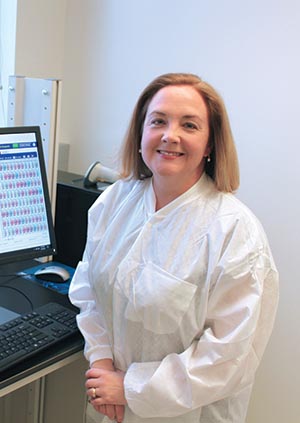
Dr. Kristy Rae-Collins Crooks (98C)
COVID-19 testing
on the fast track
At the University of Colorado’s Anschutz Medical Campus, Dr. Kristy Rae-Collins Crooks directs what many would consider one of the most sophisticated types of genetics laboratories in the world.
The Biobank Laboratory of the Colorado Center for Personalized Medicine performs research and clinical genetic testing on donated patient samples to generate large-scale genetic data, which, when combined with medical information from the electronic health record, can help shed new light on why some people are more likely to get certain diseases and which treatments will work best on which individuals.
But early in March 2020, Crooks received entirely different marching orders for the lab that she was more than eager to follow: enable it to process thousands of COVID-19 tests. Fast.
Top leadership at the institution directed the Biobank to begin running a clinical COVID-19 test – one different from those used by the medical center’s patient-care labs. Why? To guard against potential supply-chain issues with vendors providing COVID testing reagents to the clinical laboratories. Good idea.
The Biobank Lab was well suited to the task, boasting an instrument capable of fast, high-volume processing of a totally new COVID-19 assay, or test, just authorized by the FDA under its Emergency Use Authorization. But clinical laboratory regulations require validation of assay performance before beginning patient testing, and the campus was on shut-down with most staff on work-from-home orders. When the university gave the green light for two people to work on the assay, Crooks and Clinical Fellow Dr. Stephen Wicks set to the task immediately.
“I hadn’t personally been at the lab bench in many years,” Crooks said, “but for this project, I needed to be and was glad to do it.”
Eight 15-hour days later, the duo finished running the assay under all conditions required by the FDA.
“We had to be certain that the test is accurate and that it detects very, very small amounts of the virus in your sample,” Crooks explained. “We had to be sure that it doesn’t matter if your sample is a swab, lavage or sputum, and that the test works the same on every instrument in our lab so that it doesn’t matter if we use the older machine by the window or the new one two benches over. And we had to prove that we can get your sample in and get the results back to your doctor responsibly and quickly.”
Next, Crooks had to ensure proper training of her staff and implement longer shifts to accommodate the new work. All these efforts – and the March decision to use a different method of COVID-19 testing – were validated in June when the vendor providing reagents for the medical center’s primary clinical COVID assay was forced to cut deliveries in half. Almost overnight, the Biobank Lab’s COVID-19 test volume soared from a couple hundred a month to 1,000 to 1,500 a day.
“We had huge support across campus when we were bringing up the test,” Crooks remembered about those long days at the lab bench. “We kept our eye on the fact that if we don’t do it quickly and well, bad things are going to happen in public health and, God forbid, to our friends, neighbors and families.”
Impressive Credentials
In addition to directing the Biobank Laboratory, Crooks is an assistant professor of pathology, director of the heritable disease section in the Colorado Molecular Correlates Laboratory, and director of the Laboratory Genetics and Genomics Fellowship.
The Berry biology major earned a Ph.D. in neurobiology at Duke University followed by a postdoctoral fellowship in Duke’s Center for Human Genetics. Next, she performed fellowships in Clinical Molecular Genetics and Clinical Cytogenetics at the University of North Carolina at Chapel Hill, leading to board certification and the ability to work directly with patients in both.
Now, she calls her work “directing a fairly typical clinical genetics laboratory” through which she provides genetic diagnosis for such diseases as Huntington’s and cystic fibrosis, as well as diagnosis and prognosis for cancer.
The Magic of Mentors
Crooks’ love of science was cemented during a Summer Undergraduate Research Experience program at Emory University when she had the opportunity to work with human mummies, a subject of great interest. (Another student in the program also was of great interest: She met and later married Dr. Jim Crooks, and they now have two sons: Joey, 15, and Charlie, 12.) The Berry junior loved the careful note-taking and later used the data captured during the imaging of the mummies’ bones as the basis of her Berry Honors Thesis.
The other catalysts for her commitment to science had names: Dr. Martin Cipollini, Dana professor of biology; Dr. Chris Mowry, associate professor of biology; and Dr. Donald Bettler (FFS), all of whom loved sharing their knowledge and made her feel like she really could be a scientist.
“Most of the technical and scientific skills I’ve needed are ones I learned during my Ph.D. and clinical fellowships,” she concluded. “But many of the soft skills – compassion when my students and staff are struggling; motivation to work harder when the stakes are high; remembering to listen to every voice in the room, even when I already think I’m right – are things I started building at Berry.”
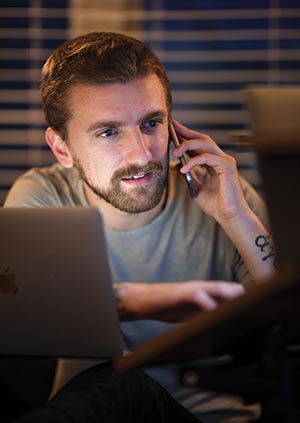
Noah Stewart (17C)
Global-trade savvy
fulfills PPE fund promise
Arnold Swartzenegger can do just about anything on the movie screen, but none of the characters he plays could do what Noah Stewart did.
In the first four months of the COVID-19 pandemic, when frontline responders across the nation were scrambling to get their hands on gowns, masks and gloves, Stewart helped his team at global freight employer Flexport deliver 166 million units of personal protective equipment directly to those most in need.
Their work fulfilled the promise of the highly successful Frontline Responders Fund established by Schwarzenegger and actor/filmmaker Edward Norton in concert with Flexport CEO Ryan Peterson and a handful of others. The goal: To raise funds for Flexport’s nonprofit arm – Flexport.org – in order to get PPE from other countries into the U.S.
“There was a major backlog in the supply chain,” Stewart explained. “And the cost of shipping the bulky items went way up, so many that could buy PPE couldn’t afford the shipping.”
Tweets then Trade
Schwarzenegger, the largest donor to the project, tweeted about the backlog in the supply chain and the need for donations to the fund. Other high-profile celebrities such as Ashton Kutcher, Kim Kardashian and Ellen followed his lead. When the fund kicked off on GoFundMe.com, Flexport’s Peterson tweeted that anyone needing to find PPE should reach out. The result was a deluge of interest. Pleas for help, really.
Enter Stewart. And the remarkable technical capabilities of Flexport, which seeks to modernize global trade by uniquely combining advanced cloud technology and analytics, logistics infrastructure, and human expertise.
“The small Flexport.org team couldn’t handle the volume, so we jumped on board to help,” said Stewart, the market development manager in Flexport’s Atlanta office. “We had suppliers wanting buyers and buyers with no verified suppliers or no money to move the freight. Almost overnight, my team set up a funnel.”
The people who wanted to import PPE were established as “buyers of record,” and Stewart’s team built a supply chain connection for each request. They established an approved network of suppliers, vetting each to ensure they met FDA regulations. Orders went out, and PPE was received directly by the buyer with no delays. More than 90% of supplies came from China, the rest from Southeast Asian countries, Japan and India.
“The Frontline Responders Fund covered the logistical movement – the cost of the air or ocean freight – as well as customs support, including import taxes,” he said. “And in some cases, it paid for the PPE itself.”
The original goal for the Frontline Responders Fund was $5 million. As of Nov. 1, it sat at $8.3 million.
Head, Heart, Hands and Data Analysis
Stewart’s path to a career in a technically oriented business was a thoughtful one.
“I was a religion and philosophy major,” he stated. “My freshman year, I took a course with Dr. Peter Yoder that excited me and opened my eyes in so many ways. Still, I felt I should major in business, but I wasn’t eager to make the change. I was working with Dr. [Gary] Waters [80C, 89G], who had a great influence on me. He suggested I major in something I love, something that truly interested and challenged me.
“He also showed me how to be successful in a business setting – how to act professionally, how to lead a meeting to a successful conclusion. He taught me leadership skills.
“Really, between Dr. Waters, President [Steve] Briggs and Mr. [Rufus] Massey [75C], I learned how to step up and fix a problem. I was treated like an equal by all three.”
He was so much an equal that at one point he was invited to present the enrollment data analysis he had done as a student worker to the Berry Board of Trustees. The project was one he developed on his own, selecting the data-analysis software, teaching himself how to use it, and coaxing it to offer up important information never before available.
“Noah is a great example of a liberal arts education,” said Waters, Berry vice president emeritus. “He was interested in everything and built on each interest to get a total package.”
It All Comes Together
Throughout his years at Berry, Stewart was very concerned about human trafficking, which he now knows is made possible by “dirty supply chains.” He also knows that solving the issue is not as simple as boycotting a certain product produced by slave labor. In large part, it comes down to international freight.
“I envision someday working on the human trafficking problem I still care so much about,” Stewart declared, “but with a strong knowledge base in international shipping so that we can actually have a strong impact.”
He also believes in Flexport’s goal to lower the cost and thus the entry point into global shipping so that smaller vendors can participate in international trade.
“Nothing lowers poverty like international trade,” he concluded.
Click here to view the complete issue of Berry Magazine
